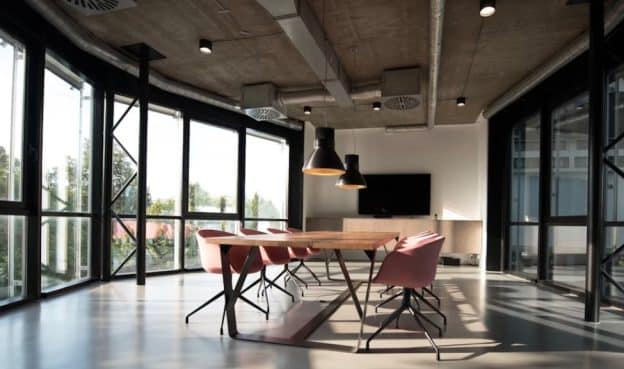As extreme weather events become more frequent and severe, businesses must proactively protect their buildings. Preparing for storms, heavy rainfall, high winds, or extreme temperatures is essential for operational continuity and employee safety. Regular inspections and maintenance, combined with early identification of weak points, can significantly reduce the risk of structural damage.
Key measures include inspecting roofs, reinforcing structural elements, and upgrading drainage systems. Consulting local roofing and restoration services, along with other maintenance professionals, helps identify vulnerabilities and prevent damage.
By taking these proactive steps, businesses can minimize financial losses while maintaining a secure environment for staff and clients.
This article outlines practical strategies companies can adopt to protect their buildings, reduce risks, and stay strong during extreme weather events.
Assess Weather Risks and Infrastructure Vulnerabilities
Businesses need to assess site-specific vulnerabilities, as data from NASA reveals an alarming, unforeseen rise in the intensity of extreme weather events. According to The Guardian, these climate-driven events are becoming more frequent and severe, with impacts sometimes outpacing global temperature increases.
Since threats vary, from coastal flooding to inland wildfires and tornadoes, initial resilience efforts must include site-specific risk assessments. Inspections should evaluate structural integrity, roofs, windows, insulation, electrical systems, and drainage.
Identifying weak points, such as unsealed roofs or aging windows, enables targeted upgrades. Proactive maintenance is far more cost-effective than post-disaster repairs or insurance claims.
Fortify Building Structures for Resilience
After the assessment, reinforcement should focus on the most exposed areas of the building. Structural reinforcements, including strongermaterials, protective coatings, and weather-resistant windows, help reduce damage from wind, rain, and debris.
Upgrading roofing systems with heavy-duty shingles or coated membranes can drastically reduce leak risks in storm-prone areas. Installing flood barriers or raised landscaping structures can redirect water flow and prevent flooding. For wildfire-prone zones, businesses can benefit from non-combustible exteriors like metal siding and ember-resistant vents.
Additionally, reinforcing entry points such as doors and garage openings reduces wind pressure buildup inside buildings, lowering the risk of collapse. HVAC systems should also be protected with surge suppressors and backups to avoid system failures during electrical storms.
Prioritize Roof Protection and Post-Storm Restoration
The roof serves as the first line of defense, preventing water intrusion, structural damage, and costly interruptions to business operations. Regular inspections, particularly before storm seasons, help identify issues such as leaks, loose shingles, or clogged drainage systems that could escalate into major problems.
According to Reliable Roofing & Restoration, many commercial roofs are designed to last 20 to 30 years. However, severe weather, improper installation, or lack of maintenance can significantly shorten their lifespan. While repairs may extend a roof’s usability, there are cases where full replacement offers a smarter, long-term solution.
Partnering with local roofing and restoration professionals ensures a timely response and durable results after extreme weather events. Proactive maintenance and expert guidance protect both the building and the business from avoidable losses.
Set up Backup Systems and Emergency Power Solutions
Power outages are among the most common impacts of extreme weather, making backup energy solutions essential for business continuity. Installing generators or adopting renewable options like solar panels with battery storage ensures that critical systems, lighting, servers, refrigeration, and security remain operational.
Additionally, surge protectors and uninterruptible power supplies (UPS) safeguard sensitive electronics from damage while maintaining functionality during outages.
According to Fortune Business Insights, the U.S. UPS market was valued at USD 2.69 billion in 2024. It is projected to reach USD 4.55 billion by 2032, growing at a CAGR of 6.73%. UPS devices provide temporary power during failures, protecting data and essential operations.
Businesses should also establish redundant communication channels, including internet and satellite options, to enable emergency coordination and remote check-ins. These systems ensure continuous digital communication during infrastructure disruptions, helping businesses remain resilient against unpredictable weather events.
Inspect Water Management and Drainage Systems
Effective water management is critical as heavy rainfall and flooding increasingly threaten commercial buildings.
According to the EPA, yearly rainfall has gone up worldwide and across the contiguous U.S., though some areas have seen bigger changes than others. Since 1901, global rainfall has grown by about 0.03 inches per decade, while in the contiguous U.S., it has increased by 0.18 inches per decade. Some regions, like the Southwest, have experienced decreases in precipitation.
Businesses should ensure proper drainage and waterproofing to protect structures and foundations. Regular gutter maintenance, French drains, and graded landscaping can redirect stormwater away from buildings. Basements should use flood-resistant materials and sump pumps with backup power.
In flood-prone areas, elevating critical equipment can minimize damage. Proper water management prevents structural issues and limits mold and contaminants, safeguarding employee health and ensuring facility resilience.
Create a Comprehensive Disaster Preparedness Plan
Physical resilience must be backed by an operational disaster preparedness plan. This must outline evacuation routes, communication procedures, and backup workflows to ensure business continuity, allowing work to resume remotely during repairs. Staff training is critical, ensuring every employee knows their emergency role.
Concurrently, businesses must review their insurance coverage. Springer Nature notes that the rising frequency of natural disasters widens the insurance coverage gap. This often results in higher premiums or the unavailability of certain services.
Therefore, confirming policies cover natural disasters and restoration is crucial. Documenting and integrating this plan transforms a temporary setback into a manageable risk.
FAQs
What is the quickest way to stop a major roof leak?
The fastest way to fix a leaking roof is to apply a temporary patch or sealant over the affected area. Use roofing tape, waterproof tarps, or roof cement to stop water intrusion immediately. For long-term protection, schedule professional inspection and permanent repairs as soon as possible.
How to make an office building climate resilient?
Making an office building climate resilient requires proactive planning, risk assessment, and investment in durable infrastructure. It involves anticipating extreme weather, strengthening structures, and ensuring systems like power, water, and drainage can withstand disruptions. Preparedness, ongoing maintenance, and expert guidance help businesses protect assets, maintain operations, and safeguard occupants.
How often should businesses conduct weather-resilience inspections?
Businesses should conduct weather-resilienceinspections at least annually, ideally before peak storm or extreme weather seasons. Regular checks help identify structural weaknesses, maintenance needs, and system vulnerabilities. Additional inspections may be necessary after severe weather events to ensure continued safety, operational continuity, and protection of employees and assets.
Extreme weather is a constant risk for modern businesses. Preparing buildings through inspections, structural reinforcement, effective drainage, and collaboration with local professionals can significantly reduce damage and support rapid recovery.
Investments in weatherproofing, backup power, and restoration partnerships today will pay off when disasters occur. In an era of unpredictable climate events, preparedness isn’t just a precaution. It’s a business necessity.


